
Gluten Intolerance Symptoms
Share
Gluten-free diets are popular, but unless a person suffers from celiac disease or gluten intolerance, there is no scientific evidence that indicates a connection between better overall health and avoiding gluten-containing foods.
Gluten intolerance isn’t the same as a wheat allergy or celiac disease. A wheat allergy may be severe and life-threatening, and celiac disease, which affects 1% of the U.S. population, causes damage to the digestive system.
The terms gluten intolerance and gluten sensitivity may be used interchangeably, and the condition may also be referred to as non-celiac gluten sensitivity (NCGS).
Celiac disease vs. gluten intolerance
Celiac disease and gluten intolerance or gluten sensitivity cause different responses in affected people. In both groups of people, ingesting gluten-containing foods triggers a series of common gastrointestinal symptoms.
If you suspect that you are sensitive to gluten or have celiac disease, it’s important to seek the advice of your primary care physician right away. Your physician can administer a blood test or a skin prick test to determine whether you test positive for celiac disease. Intestinal damage and certain antibodies are hallmarks of celiac disease.
People who begin a gluten-free diet before seeking the advice of their doctor risk producing a false negative, because their body will stop making the antibodies that indicate a misfire in their immune system.
When people experiencing symptoms indicating a possibility of celiac disease seek treatment and test negative, they may receive a diagnosis of gluten intolerance or gluten sensitivity. People who don’t show clinical signs of celiac but experience occasional upset stomach, gas, bloating or diarrhea may have an intolerance to gluten. Gluten intolerance is defined by a study posted on BMC Medicine as “not accompanied by the concurrence of tTG or autoimmune comorbidities.”
Like what you're reading? Like us on Facebook for more blogs and giveaways!
Gluten consumption and symptoms
For people with gluten sensitivity, a flare-up of symptoms can be painful and inconvenient, but symptoms may disappear when the affected person stops eating gluten-containing foods.
In a scientific study conducted in 38 Italian medical facilities, 486 patients with symptoms of gluten sensitivity indicated that their symptoms appeared between one hour and 24 hours after ingesting gluten.
The most common complaint among people who believe they are sensitive to gluten-containing foods is bloating and stomach discomfort. Other specific gastrointestinal symptoms of gluten sensitivity identified in the study include:
- Diarrhea
- Constipation
- Nausea
- Discomfort in the upper abdomen
- Occasional Heartburn
Some symptoms of gluten intolerance identified by people included in the study aren’t digestive-related problems. These systematic symptoms can be more difficult for sufferers to identify and communicate to health practitioners.
- Feeling sad or blue
- Foggy mind
- Fatigue
- Itchy skin
- Joint or muscle discomfort
Diagnosing gluten sensitivity or gluten intolerance
While no non-celiac gluten sensitivity biomarker test is available, there is a standardized procedure that leads to a confirmed diagnosis of gluten sensitivity that’s widely accepted in the medical community.
The Salerno Experts’ Criteria calls for an assessment of the clinical response to a gluten-free diet (https://www.ncbi.nlm.nih.gov/pubmed/26096570). Using a symptom rating scale of one through ten (one being mild and ten being severe), patients rate their symptoms before and after beginning a gluten-free diet. Clinicians look for a 30% change in symptoms before making a positive diagnosis of non-celiac gluten sensitivity.
Gluten intolerance relief
Many symptoms can be attributed to gluten intolerance. Many of them have several common causes, however. Experimenting with a gluten-free diet and noting any changes in symptoms is an option that many people choose, to learn more about what’s causing their discomfort.
Enzymedica has two enzyme blends specifically designed to help your body digest gluten. GlutenEase is perfect if your symptoms are moderate. If you don't intend on changing your diet, it's good for daily support to help prevent intolerance symptoms. GlutenEase Extra Strength is designed for more severe or uncomfortable symptoms. It's ideal if you're avoiding gluten entirely, to aid the digestive system in the event of accidental consumption. These products cannot replace a gluten free-diet for those with celiac disease, but they give our digestive system extra assistance to optimize the breakdown of gluten and casein.
Many people who believe they suffer from gluten intolerance note that their discomfort is temporary and that symptoms may be inconsistent or worse with certain types of gluten-containing foods. The easiest way to find out if gluten-containing foods cause symptoms of gluten intolerance is to simply stop eating them. (However, as noted above, if you plan to see a doctor to confirm your suspicion that you don’t tolerate gluten well, wait until after any diagnostic tests to change your diet.)
The gluten-free diet isn’t as mysterious as it was even a few years ago. If you decide to embark on a gluten-free diet, be aware that you must make an effort to replace gluten-containing foods with foods with plenty of B vitamins and fiber ("How to get Fiber While Eating Gluten Free"), like beans, fruits and vegetables. It may be beneficial to add a gluten-free supplement that contains B vitamins if you are contemplating a gluten-free diet.

